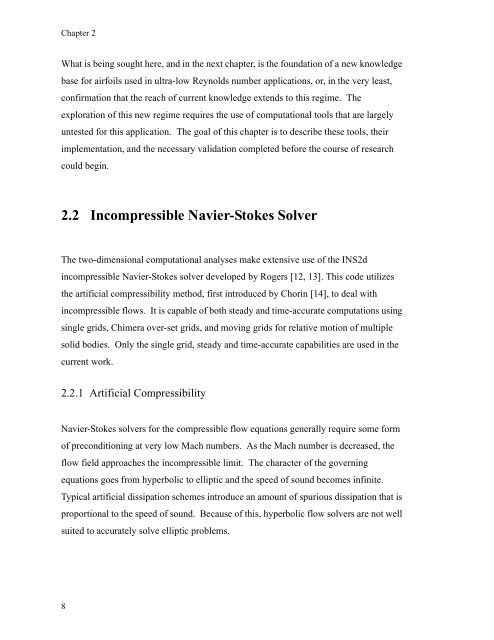Aerodynamics and Design for Ultra-Low Reynolds Number Flight
Aerodynamics and Design for Ultra-Low Reynolds Number Flight
Aerodynamics and Design for Ultra-Low Reynolds Number Flight
You also want an ePaper? Increase the reach of your titles
YUMPU automatically turns print PDFs into web optimized ePapers that Google loves.
Chapter 2<br />
What is being sought here, <strong>and</strong> in the next chapter, is the foundation of a new knowledge<br />
base <strong>for</strong> airfoils used in ultra-low <strong>Reynolds</strong> number applications, or, in the very least,<br />
confirmation that the reach of current knowledge extends to this regime. The<br />
exploration of this new regime requires the use of computational tools that are largely<br />
untested <strong>for</strong> this application. The goal of this chapter is to describe these tools, their<br />
implementation, <strong>and</strong> the necessary validation completed be<strong>for</strong>e the course of research<br />
could begin.<br />
2.2 Incompressible Navier-Stokes Solver<br />
The two-dimensional computational analyses make extensive use of the INS2d<br />
incompressible Navier-Stokes solver developed by Rogers [12, 13]. This code utilizes<br />
the artificial compressibility method, first introduced by Chorin [14], to deal with<br />
incompressible flows. It is capable of both steady <strong>and</strong> time-accurate computations using<br />
single grids, Chimera over-set grids, <strong>and</strong> moving grids <strong>for</strong> relative motion of multiple<br />
solid bodies. Only the single grid, steady <strong>and</strong> time-accurate capabilities are used in the<br />
current work.<br />
2.2.1 Artificial Compressibility<br />
Navier-Stokes solvers <strong>for</strong> the compressible flow equations generally require some <strong>for</strong>m<br />
of preconditioning at very low Mach numbers. As the Mach number is decreased, the<br />
flow field approaches the incompressible limit. The character of the governing<br />
equations goes from hyperbolic to elliptic <strong>and</strong> the speed of sound becomes infinite.<br />
Typical artificial dissipation schemes introduce an amount of spurious dissipation that is<br />
proportional to the speed of sound. Because of this, hyperbolic flow solvers are not well<br />
suited to accurately solve elliptic problems.<br />
8




